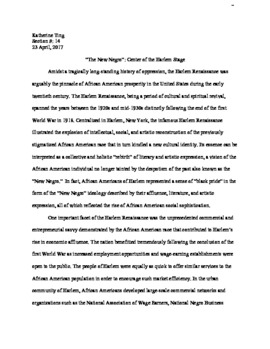| dc.description.abstract | Amidst a tragically long-standing history of oppression, the Harlem Renaissance was arguably the pinnacle of African American prosperity in the United States during the early twentieth century. The Harlem Renaissance, being a period of cultural and spiritual revival, spanned the years between the 1920s and mid-1930s distinctly following the end of the first World War in 1918. Centralized in Harlem, New York, the infamous Harlem Renaissance illustrated the explosion of intellectual, social, and artistic reconstruction of the previously stigmatized African American race that in turn kindled a new cultural identity. Its essence can be interpreted as a collective and holistic "rebirth" of literary and artistic expression, a vision of the African American individual no longer tainted by the despotism of the past also known as the "New Negro." In fact, African Americans of Harlem represented a sense of "black pride" in the form of the "New Negro" ideology described by their affluence, literature, and artistic expression, all of which reflected the rise of African American social sophistication. | |
